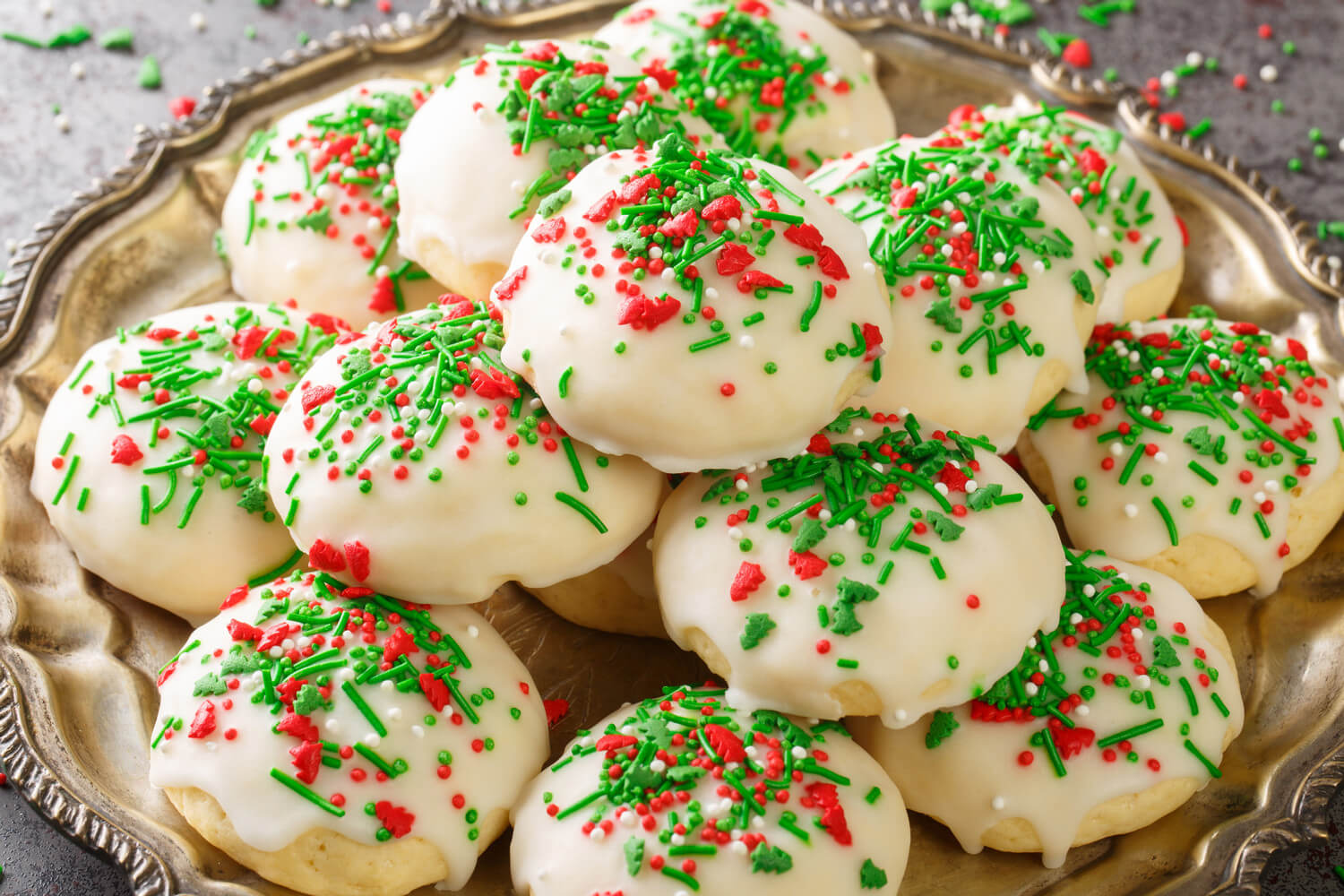Italian Ricotta Cookies are more than just a delightful treat; they are a testament to the rich culinary heritage of Italy. These cookies, known for their soft texture and subtle sweetness, have been a staple in Italian households for generations, especially during festive seasons like Christmas and Easter. Originating from the heart of Italy, these cookies have traversed borders, winning hearts worldwide with their unique flavor and texture.
What sets Italian Ricotta Cookies apart is their main ingredient, ricotta cheese, which imparts a moistness and richness unparalleled in other cookie varieties. This article delves deep into the world of these beloved cookies, guiding you through every step of creating your own batch of heavenly treats. From the key ingredients that make them special to the nuances of baking them to perfection, we’ve got you covered.
To understand more about the roots of these and other Italian delicacies, explore the History of Italian Cuisine.
What Makes Italian Ricotta Cookies Special?
The Unique Blend of Ingredients
The secret behind the exceptional taste of Italian Ricotta Cookies lies in their unique blend of ingredients. The star, ricotta cheese, is not a typical cookie ingredient. This Italian whey cheese brings a creamy texture and a slightly tangy taste, setting these cookies apart from their counterparts. The addition of lemon zest or almond extract infuses a subtle yet distinct flavor, enhancing the overall taste profile.
A Comparison with Other Italian Cookies
When compared to other Italian cookies like biscotti or amaretti, Italian Ricotta Cookies stand out for their soft, cake-like texture. Unlike the crunchy biscotti or the chewy amaretti, these cookies offer a melt-in-your-mouth experience, thanks to the moisture-rich ricotta. This unique texture combined with their light, airy feel makes them a favorite among cookie lovers of all ages.
Italian Ricotta Cookies Ingredients and Their Roles
The Foundation of Flavor
Creating the perfect Italian Ricotta Cookies starts with precise measurements and understanding the role of each ingredient. Here’s a detailed breakdown:
- Ricotta Cheese: 1 cup (250 grams) – The star of the recipe, ricotta cheese, adds moisture and richness, ensuring the cookies are soft and tender.
- Butter: 1/2 cup (115 grams), softened – Butter is the base for a fluffy texture. It should be creamed with sugar to introduce air into the batter, contributing to the lightness of the cookies.
- Sugar: 1 cup (200 grams) – Sugar not only sweetens the cookies but also helps in achieving a golden-brown color and crisp edges when baked.
- Eggs: 2 large – Eggs act as a binder, holding the ingredients together and adding structure to the cookies.
- All-Purpose Flour: 2 1/2 cups (312 grams) – Flour provides the necessary structure. The right amount ensures the cookies are soft but not overly crumbly.
- Baking Powder: 1 teaspoon (4 grams) – Baking powder is a leavening agent that helps the cookies rise and maintain a soft texture.
- Vanilla Extract: 1 teaspoon (5 ml) – Vanilla adds a subtle, sweet flavor. It enhances the overall taste profile of the cookies.
- Lemon Zest: 1 tablespoon (optional) – For a citrusy twist, lemon zest can be added. It gives a refreshing aroma and a slight tangy taste.
Complement these cookies with a homemade Lemon Curd for an extra zesty treat.
The Art of Balancing Ingredients
Achieving the perfect balance of these ingredients is key. Too much ricotta can make the cookies too dense, while too little may result in a lack of moisture. The right proportion of flour ensures the cookies are soft but not overly crumbly.
Preparing the Italian Ricotta Cookie Guide
Preparing the Dough
- Creaming Butter and Sugar: Start by creaming together butter and sugar until light and fluffy. This step is crucial for incorporating air into the batter.
- Incorporating Ricotta and Eggs: Add ricotta cheese to the mixture, followed by the eggs, one at a time. Mix until well combined.
- Dry Ingredients: In a separate bowl, whisk together the flour and baking powder. Gradually add this to the wet mixture, mixing until just combined.
- Flavorings: Stir in your choice of flavorings – be it lemon zest, vanilla, or almond extract.
Baking to Perfection
- Shaping the Cookies: Drop spoonfuls of the dough onto a baking sheet lined with parchment paper. Leave enough space between each as they will spread slightly.
- Baking Time: Bake in a preheated oven at a moderate temperature until the edges are just golden. This ensures a soft center with a slightly crisp edge.
- Cooling: Allow the cookies to cool on the baking sheet for a few minutes before transferring them to a wire rack.
Consider the fascinating Science of Baking to understand how each ingredient works together to create these delightful cookies.
Variations of the Italian Ricotta Cookie Recipe
Embracing Regional Differences
Italian Ricotta Cookies are not just a single recipe but a tapestry of variations, each reflecting the culinary traditions of different Italian regions. Some variations include:
- Citrus Flavors: In some regions, orange or lemon zest is added for a refreshing citrus twist.
- Chocolate Chips: For a richer flavor, some bakers add chocolate chips to the dough.
- Spices: Ingredients like cinnamon or nutmeg can be included for a warm, spicy note.
Modern Twists
Contemporary versions of this classic recipe have also emerged, catering to diverse palates and dietary needs:
- Gluten-Free Options: By substituting all-purpose flour with gluten-free alternatives, these cookies can be enjoyed by those with gluten sensitivities.
- Vegan Variations: Replacing dairy ingredients with plant-based alternatives like almond milk ricotta and vegan butter makes these cookies accessible to vegan diets.
For bakers looking to explore other unique cookie recipes, our Pumpkin Spice Ginger Cookies offer a delightful twist on traditional flavors.
Decorating and Serving Suggestions
The Art of Decoration
The final touch to Italian Ricotta Cookies is in their decoration, which can be as simple or elaborate as desired:
- Icing: A simple glaze made from powdered sugar and milk or lemon juice is commonly used. It can be colored or flavored to match the occasion.
- Sprinkles: Add a festive touch with sprinkles, suited for holidays or celebrations.
Serving with Style
These cookies are versatile in serving:
- With Coffee or Tea: Their subtle sweetness pairs wonderfully with a hot cup of coffee or tea.
- As Dessert: Serve them as a light dessert, perhaps accompanied by a scoop of gelato.
After mastering Italian Ricotta Cookies, why not try your hand at another sweet creation? Our Zucchini Muffins with Chocolate Chips are sure to impress. And for those days when you’re in the mood for something savory, this Cheesy Broccoli Casserole can be a perfect accompaniment.
Storing and Preservation Tips
Ensuring Freshness
Proper storage is key to maintaining the freshness and texture of Italian Ricotta Cookies. Here are some tips:
- Room Temperature Storage: Store the cookies in an airtight container at room temperature for up to a week.
- Refrigeration: For longer storage, refrigerate them. This is especially recommended if you live in a humid climate or if the cookies have a high dairy content icing.
Freezing for Longevity
- Freezing the Dough: You can freeze the cookie dough for up to 3 months. Wrap it tightly in plastic wrap and place it in a freezer bag.
- Freezing Baked Cookies: Fully baked cookies can also be frozen. Once they are completely cooled, place them in a freezer-safe container, separating layers with parchment paper.
Nutritional Information
Understanding the Dietary Impact
While Italian Ricotta Cookies are a delightful treat, being mindful of their nutritional content is important, especially for those monitoring their dietary intake. A typical cookie contains:
- Calories: Varies, but generally around 70-100 calories per cookie.
- Carbohydrates: Primarily from sugar and flour.
- Fats: From butter and ricotta cheese.
- Protein: Modest amounts from eggs and ricotta cheese.
Dietary Considerations
For those with specific dietary needs, here are some considerations:
- Gluten-Free: Use gluten-free flour for a gluten-free version.
- Reduced Sugar: Reduce the sugar amount or use sugar substitutes for a less sweet version.
While enjoying the art of baking these cookies, it’s also worth exploring the Benefits of Baking as a Hobby, which extends beyond just delicious outcomes.
Common Mistakes and Troubleshooting
Avoiding Pitfalls
Even experienced bakers can encounter issues when making Italian Ricotta Cookies. Here are some common mistakes and how to avoid them:
- Overmixing the Dough: This can lead to tough cookies. Mix just until the ingredients are combined.
- Using Cold Ingredients: Ensure your butter, eggs, and ricotta are at room temperature for a smoother batter.
- Inconsistent Cookie Sizes: Use a cookie scoop for uniform size, which ensures even baking.
Troubleshooting Tips
If you run into problems, here are some quick fixes:
- Cookies Too Flat: This could be due to melted butter or overmixing. Chill the dough before baking to help retain shape.
- Cookies Not Fluffy Enough: Check your baking powder to ensure it’s still active.
- Icing Too Runny or Thick: Adjust the consistency with more powdered sugar or liquid, respectively.
And for those who love to balance their sweet treats with savory masterpieces, why not try making a Prime Rib Roast next?
FAQs about Italian Ricotta Cookies
- Can I Use Different Types of Ricotta?
- Yes, but the texture may vary. Whole milk ricotta is recommended for its creaminess.
- How Long Do These Cookies Last?
- They can last up to a week at room temperature or longer if refrigerated.
- Can I Freeze the Dough?
- Absolutely. The dough can be frozen for up to 3 months.
- Are There Vegan Alternatives for the Ingredients?
- Yes, you can use plant-based ricotta and butter substitutes.
- Can I Make These Cookies Gluten-Free?
- Definitely. Use a gluten-free flour blend suitable for baking.
Conclusion
As we reach the end of our culinary journey with Italian Ricotta Cookies, it’s clear that these delightful treats are more than just a recipe; they are a celebration of tradition, flavor, and the joys of baking. From the creamy richness of ricotta to the subtle zest of lemon, each ingredient plays a crucial role in creating a cookie that is not just delicious but also a testament to the timeless charm of Italian baking.
These cookies, with their soft texture and versatile nature, are perfect for any occasion, be it a festive celebration, a cozy family gathering, or a quiet moment with a cup of tea. The joy of sharing these homemade delights with loved ones adds to their special appeal. Moreover, the versatility of the recipe allows for creativity and adaptation, making it a delightful challenge for both novice and experienced bakers.
As you embark on your own baking adventure, remember that each batch of cookies is a new opportunity to perfect the art, experiment with flavors, and most importantly, to create warm memories. Whether you stick to the traditional recipe or infuse it with your own creative twists, the process of baking Italian Ricotta Cookies is as rewarding as the smiles they bring to those who taste them.
In the end, the true essence of these cookies lies in the love and care that goes into baking them. They are not just a treat for the palate but a heartfelt expression of culinary artistry. So, preheat your oven, gather your ingredients, and let the magic of Italian Ricotta Cookies fill your kitchen with warmth and your heart with joy.

